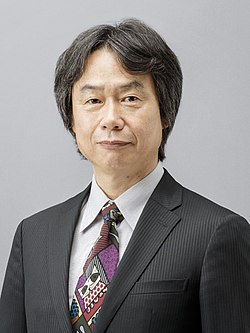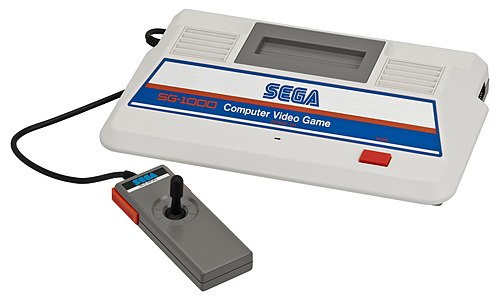Portal:Video games
The Video Games Portal

A video game or computer game is an electronic game that involves interaction with a user interface or input device (such as a joystick, controller, keyboard, or motion sensing device) to generate visual feedback from a display device, most commonly shown in a video format on a television set, computer monitor, flat-panel display or touchscreen on handheld devices, or a virtual reality headset. Most modern video games are audiovisual, with audio complement delivered through speakers or headphones, and sometimes also with other types of sensory feedback (e.g., haptic technology that provides tactile sensations). Some video games also allow microphone and webcam inputs for in-game chatting and livestreaming.
Video games are typically categorized according to their hardware platform, which traditionally includes arcade video games, console games, and computer games (which includes LAN games, online games, and browser games). More recently, the video game industry has expanded onto mobile gaming through mobile devices (such as smartphones and tablet computers), virtual and augmented reality systems, and remote cloud gaming. Video games are also classified into a wide range of genres based on their style of gameplay and target audience. (Full article...)
Featured articles –

The Magnavox Odyssey is the first commercial home video game console. The hardware was designed by a small team led by Ralph H. Baer at Sanders Associates, while Magnavox completed development and released it in the United States in September 1972 and overseas the following year. The Odyssey consists of a white, black, and brown box that connects to a television set, and two rectangular controllers attached by wires. It is capable of displaying three square dots and one line of varying height on the screen in monochrome black and white, with differing behavior for the dots depending on the game played. Players place plastic overlays on the screen to display additional visual elements for each game, and one or two players for each game control their dots with the knobs and buttons on the controller by the rules given for the game. The console cannot generate audio or track scores. The Odyssey console came packaged with dice, paper money, and other board game paraphernalia to accompany the games, while a peripheral controller—the first video game light gun—was sold separately.
The idea for a video game console was conceived by Baer in August 1966. Over the next three years he, along with Bill Harrison and Bill Rusch, created seven successive prototype consoles. The seventh, known as the Brown Box, was shown to several manufacturers before Magnavox agreed to produce it in January 1971. After releasing the console through their dealerships, Magnavox sold 69,000 units in its first calendar year and 350,000 by the time the console was discontinued in 1975. The console spawned the Odyssey series of dedicated consoles as well as the 1978 Magnavox Odyssey 2. One of the 28 games made for the system, a ping-pong game, was an inspiration for Atari's successful 1972 Pong arcade game, in turn driving sales of the Odyssey. Patents by Baer and the other developers for the system and the games, including what was termed by a judge as "the pioneering patent of the video game art", formed the basis of a series of lawsuits spanning 20 years, earning Sanders and Magnavox over US$100 million. The release of the Odyssey marked the beginning of the first generation of video game consoles and was an early part of the rise of the commercial video game industry. (Full article...)
Claire is the protagonist of several Resident Evil games, novels, and films, and has appeared in other franchises, including Monster Hunter and Teppen. Several actors have portrayed Claire; in Resident Evil 2 (1998) , she is voiced by Alyson Court, whose features were later used for the character. In the 2019 remake of Resident Evil 2, she is voiced by Stephanie Panisello and modeled on the Canadian model Jordan McEwen. In the live-action Resident Evil films, Claire has been portrayed by Ali Larter and Kaya Scodelario.
Critics have positively responded to Claire's personality and her role as a strong, female lead character. Several journalists considered Claire to be significantly less-sexualized than other female game characters. She was exemplified as a female character who is as competent and skilled as her male counterparts. (Full article...)
Set in the fantasy world of Spira, a setting influenced by the South Pacific, Thailand and Japan, the game's story revolves around a group of adventurers and their quest to defeat a rampaging monster known as Sin. The player character is Tidus, a star athlete in the fictional sport of blitzball, who finds himself in Spira after Sin attacked his home city of Zanarkand. Shortly after arriving to Spira, Tidus becomes a guardian to summoner Yuna to destroy Sin upon learning its true identity is that of his missing father, Jecht.
Development of Final Fantasy X began in 1999, with a budget of more than $32.3 million ($61 million in 2024 dollars) and a team of more than 100 people. The game was the first in the main series not entirely scored by Nobuo Uematsu; Masashi Hamauzu and Junya Nakano were signed as Uematsu's fellow composers. Final Fantasy X was both a critical and commercial success, shipping over 8.5 million units worldwide on PlayStation 2. It is considered to be one of the greatest video games of all time. It was followed by Final Fantasy X-2 in March 2003, making it the first Final Fantasy game to have a direct game sequel. As of September 2021, the Final Fantasy X series had sold over 20.8 million units worldwide, and at the end of March 2022 had surpassed 21.1 million. A remaster, Final Fantasy X/X-2 HD Remaster was released for the PlayStation 3 and PlayStation Vita in 2013, for PlayStation 4 in 2015, Windows in 2016, and for Nintendo Switch and Xbox One in 2019. (Full article...)
The gameplay is similar to that of the previous installments, and focuses on combo-based combat, achieved through the player's main weapon—the Blades of Athena—and a secondary weapon acquired later in the game. It features quick time events that require the player to complete various game controller actions in a timed sequence to defeat stronger enemies and bosses. Up to three magical attacks and a power-enhancing ability can be used as alternative combat options. Ghost of Sparta also features puzzles and platforming elements. The combat system was updated with significantly more gameplay elements than its previous PSP installment, God of War: Chains of Olympus.
Ghost of Sparta received positive reviews from critics for its story, scope, and graphical illustration, though criticism was given for the general lack of gameplay innovation from its predecessor, Chains of Olympus. Several critics consider it to be the best-looking game on the PSP. Others have compared the overall game to those on the PlayStation 3 (PS3), and some have said that the graphics are better than those of the PlayStation 2 (PS2). Ghost of Sparta received several awards, including "Best Handheld Game", "Best PSP Game", and "PSP Game of Show" at the 2010 Electronic Entertainment Expo (E3), "Best Handheld Game" at the 2010 Spike Video Game Awards, and "Portable Game of the Year" at the 14th Annual Interactive Achievement Awards. By June 2012, it had sold almost 3.2 million copies worldwide, making it the nineteenth best-selling PlayStation Portable game of all time. Together with Chains of Olympus, Ghost of Sparta was remastered and released on September 13, 2011, as part of the God of War: Origins Collection and the remastered version was re-released on August 28, 2012, as part of the God of War Saga, both for the PlayStation 3. (Full article...)
Cawthon conceived the idea for Five Nights at Freddy's based on criticism of his previous game, Chipper & Sons Lumber Co. Reviewers complained of its unintentionally frightening characters that had unnatural movement, inspiring Cawthon to create an intentionally scarier experience. Developed in six months using the Clickteam Fusion 2.5 game engine, Five Nights at Freddy's was released for Windows through Desura on August 8, 2014, and through Steam on August 18. It was made available for Android, iOS, and Windows Phone later in 2014. Versions for Nintendo Switch, PlayStation 4, and Xbox One were released in 2019.
Five Nights at Freddy's received generally positive reviews from critics, many considering it a frightening and distinct horror game. Reviewers praised the atmosphere, sound design, and gameplay mechanics, although some found the jump scares repetitive and the game to have little replay value. It became the subject of Let's Play videos on YouTube and gained a large fan following. The game's success led to the launch of a media franchise, including many sequels and books, and its popularity led to several imitations and fangames. A film adaptation by Blumhouse Productions was released in 2023. (Full article...)
Did you know... -
- ... that the illustrations in the 1992 video game Tetris Classic are based on scenes from Alexander Pushkin's poem Ruslan and Ludmila?
- ... that Rockstar Vienna was the largest video game developer in Austria when it closed in 2006?
- ... that the death of a pregnant woman in a video game was written to be even darker on television?
- ... that the 1992 video game Otogirisō reinvigorated interest in adventure games in Japan?
- ... that a pink skin for Mercy in the video game Overwatch helped raise more than $12 million for breast cancer research?
- ... that the 2005 video game Bokura no Kazoku was inspired in part by the birth of its creator's first child?
- ... that the team developing the action video game Knights Contract researched European folklore on witches and witch hunts?
- ... that Splatoon 3 became the fastest-selling video game of all time in Japan three days after launch?
- ... that Justin Yu, the current Classic Tetris World Champion, is also a cellist in MIT's video game orchestra?
- ... that Cybermania '94 was the first televised video game awards show?
- ... that the contrabass trombone has experienced a revival in film music and video game soundtracks?
- ... that Elena from the video game series Street Fighter uses a capoeira fighting style, for which the development team used travel videos as reference material as they had no experience with the style?
Selected biography –
Selected image -
Recent video game-related events
- June 5, 2025 –
- Nintendo's Switch 2 video game console is released in most regions. (BBC News) (The Verge)
- April 4, 2025 – Tariffs in the second Trump administration
- Multiple companies, including Klarna, StubHub, Nintendo, and Professional Sports Authenticator, pause price-sensitive business actions in the U.S. to evaluate the impact of the recent tariff announcements. (The Wall Street Journal) (IGN) (The Verge)
- January 16, 2025 –
- Nintendo officially reveals the Nintendo Switch 2 video game console, the successor to the Nintendo Switch. (Nintendo)
Topics
Categories
Things you can do
In other Wikimedia projects
The following Wikimedia Foundation sister projects provide more on this subject:
-
Commons
Free media repository -
Wikibooks
Free textbooks and manuals -
Wikidata
Free knowledge base -
Wikinews
Free-content news -
Wikiquote
Collection of quotations -
Wikisource
Free-content library -
Wikiversity
Free learning tools -
Wiktionary
Dictionary and thesaurus














































